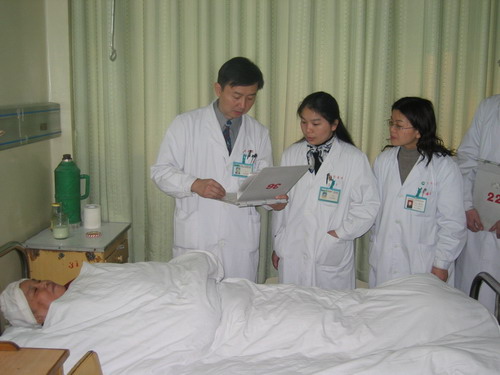Durham, NC (PRWEB) September 24, 2013, –Over the last few decades, China, like the majority of the world, has seen a steady decrease in deaths from cervical cancer, due in large part to screening efforts and improved treatment. However, the disease still poses a significant threat to women, as it remains the third most common and among the most deadly cancers in women worldwide, with a third of new cases occurring in China. Moreover, the incidence of the disease has increased among young women. These trends signal the need for a large-scale, thorough assessment of the cervical cancer landscape in China – a database that did not exist until recently.

Prof. Ding Ma (left) visits a patient at Tongji Hospital in Wuhan, China.
|
|
To address this need, Professor Ding Ma and colleagues at the Department of Obstetrics and Gynecology, Huazhong University of Science and Technology (HUST) Tongji Medical College have conducted a decade-long, retrospective, multicenter study aimed at clarifying the changing patterns of care and long-term survival rates that have accompanied the shifting demographics of cervical cancer patients in China. |
The study, which is featured in the latest issue of The Oncologist, included 10,012 patients diagnosed with cervical cancer between the years 2000 and 2009 and presents an analysis of the trends in clinical characteristics, therapeutic modalities, and treatment outcomes among the participants.
One expected result of their analysis was that patients were 5-10 years younger than they were prior to 2000 (an observation supported by several other studies). The authors speculate that this trend is due to the increasing tendency toward earlier sexual behaviors, presumably leading to more frequent transmission of the sexually transmitted virus that causes cervical cancer in young adults. When looking at regional distribution, the team discovered that a greater proportion of patients came from rural areas. Urban patients tended to be diagnosed at a significantly younger age, and they lived longer overall compared to their rural counterparts.
|
|
The proportion of patients with early stage disease upon diagnosis was found to be dramatically higher than it used to be, with more than 90% of the patients in this cohort having stage I or II tumors and only a miniscule percentage having stage IV diagnoses. This positive development is largely attributed to the popularization and widespread application of cervical cancer screening. Earlier tumor stage bodes well for prognosis and helps to explain the dramatic improvement in survival over the decades. |
Ma and colleagues also learned that treatment strategies have changed in the last decade. Where radiotherapy was previously the gold standard for cervical cancer treatment, patients now increasingly undergo surgery with adjuvant treatments. Due to the demographic shift of disease onset, many young patients opt for conservative surgeries aimed at eradicating the tumor while preserving reproductive organs and function. This is particularly important for women of childbearing age who have yet to conceive.
Overall and 5-year disease-free survival rates associated with cervical cancer have both increased in the last few decades; at 84.4% and 82.7%, respectively, they are similar to the survival rates in the US. This study found that that both types of survival worsened with increasing age and stage at diagnosis. The authors hope that the findings of this large-scale analysis will incentivize public health initiatives aimed at educating young women about sexual health and the importance of cervical cancer screening.
“This is an important paper, providing an overview of the demography and treatment of cervical cancer in China,” said Bruce A. Chabner, MD, Editor-in-Chief of The Oncologist. “The findings indicate a preponderance of surgically curable disease, in contrast to the more advanced disease found in other middle and low-income countries, for which curative treatment options may be lacking, particularly in countries with high HIV infection rates, as was recently discussed in the article Cancer in Botswana: The Second Wave of AIDS in Sub-Saharan Africa in this journal and elsewhere.”
The full article, titled “Changes in prevalence and clinical characteristics of cervical cancer in China: a study of 10,012 cases from a nationwide working group,” can be accessed at theoncologist.alphamedpress.org/content/early/2013/09/16/theoncologist.2013-0123.abstract.
About The Oncologist
Established by oncologists to help physicians better manage their practices in an ever-changing environment, The Oncologist® is the official journal of the Society for Translational Oncology (STO). Now in its 18th year, this internationally peer-reviewed journal focuses on clear and concise interpretation addressing the multimodality diagnosis, treatment, and quality of life of the cancer patient. Each issue is meant to impact the practice of oncology and to facilitate significant communication in the introduction of new medical treatments and technologies. For more information, visit http://www.TheOncologist.com.
About AlphaMed Press
Established in 1983, AlphaMed Press, with offices in Durham, NC, San Francisco, CA, and Belfast, Northern Ireland, publishes three internationally renowned peer-reviewed journals with globally recognized editorial boards dedicated to advancing knowledge and education in their focused disciplines. STEM CELLS® (http://www.StemCells.com), which celebrated its 31st year in 2013, is the world’s first journal devoted to this fast paced field of research. THE ONCOLOGIST® (http://www.TheOncologist.com), entering its 18th year, is devoted to community and hospital-based oncologists and physicians entrusted with cancer patient care. STEM CELLS TRANSLATIONAL MEDICINE® (http://www.StemCellsTM.com), in its second year, is dedicated to significantly advancing the clinical utilization of stem cell molecular and cellular biology. By bridging stem cell research and clinical trials, SCTM will help move applications of these critical investigations closer to accepted best practices.